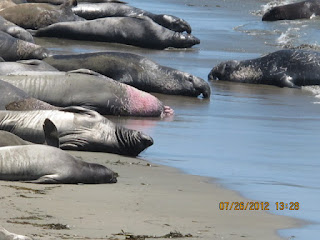Audubon published my story about how sea otter pups can be rescued:
Otter 540 washed up on California’s central coast in April 2011, a
day-old, sand-covered furball weighing just over two pounds. Otter 545
was found three weeks later. At about four and a half pounds, it was
significantly more mature than 540, having benefited from additional
time spent with its mother. The otters, both of them discovered by
beachgoers, were eventually taken to the Monterey Bay Aquarium, to be
cared for by its Sea Otter Research and Conservation program (SORAC).
While one orphan showed promise of returning to the wild, the other
seemed destined for an aquarium exhibit. This Monterey Bay Aquarium photo shows Otter 540 and her surrogate mother, Joy.
Despite their dramatically different fates, both pups represent the
challenges facing their species. With about 2,700 individuals living
along the California coast, southern sea otters are listed as threatened
under the Endangered Species Act. Through a multifaceted approach that
includes otter research, rescue, and rehabilitation as well as public
education through exhibits, SORAC is helping to bolster the population
and raise awareness about the otters’ important role in their Pacific
Ocean ecosystem. “SORAC makes it possible for each rescued stranded
animal to go into one of these research streams, as well as
rehabilitation and recovery,” says Karl Mayer, the program’s animal care
coordinator. A crucial component of SORAC’s success is a surrogate
mother program, which pairs orphaned pups with adult female otters, with
the goal of ultimately releasing them back into the wild.
SORAC has been studying otters since 1984. When it first started its
rehabilitation program, human staffers raised each individual. Those
otters became so acclimated to humans, however, that after they were
released, they approached people freely, venturing onto beaches and even
climbing onto kayaks. As adorable as they look, sea otters have sharp
teeth and may bite humans who come too close. The rehabbed otters that
had been released had to be recaptured and kept in captivity as exhibit
otters.
In 2001, SORAC started its surrogate mother program when researchers
paired an orphaned otter with a mother that had lost its own pup. The
two bonded. After that initial success, the aquarium began matching
rescued pups with female otters that hadn’t recently given birth. In
most cases, they willingly adopted the orphans.
In the wild, premature separation from their mothers is a death
sentence for young otters—they’re dependent on their mothers for roughly
six months. Rescued pups transitioning through SORAC need about 20
weeks with their adoptive parents to prepare for life in the ocean.
“When they are raised by surrogate mothers, their development is more
normal,” says Mayer. “They retain their wildness. Their survival rate is
equal to wild-raised pups.”
The program currently has two female surrogates. In addition to 22
rescued orphans that have been returned to the wild. Four released
female pups have reached adulthood and have produced 15 pups of their
own. “The criterion for success is that they must be reproductively
contributing to the population,” says Mayer.
California’s southern sea otters need all the wild members they can
get. Though scientists aren’t sure why their populations are low,
infectious diseases, including sarcocystis and toxoplasmosis, may play a
role. Shark attacks on otters have also risen in recent years as more
and more elephant seals—typical shark prey—are migrating to California’s
central coast, with their predators in pursuit.
As otter populations decline, the kelp forests where they live also
suffer. Otters are a keystone species, eating sea urchins that, in turn,
feed on kelp forests that provide habitat for many other species. “It’s
top-down control,” says Tim Tinker, a research wildlife biologist with
the Western Ecological Research Center of the U.S. Geological Survey.
Without otters, the sea urchins proliferate and devastate the kelp,
causing barren areas where few organisms can thrive.
This past April Otter 545 was released into Elkhorn
Slough, a local estuary and saltmarsh with plenty of food to support its
resident otters. Sporting purple and blue tags and a radio transmitter
implanted in its abdomen, it could be tracked and observed to gauge its
progress.
Otters have a high metabolism, and they must eat the equivalent of
about 25 percent of their body weight every day. In fact, going even
three or four days without enough food can lead them to starvation. If a
released otters isn’t eating enough, the SORAC team recaptures it and
returns it to its tank for an additional week or two before it’s again
released. “The transition from captivity to [the] wild is so difficult,”
Mayer says. “They have no experience foraging, finding food, avoiding
predators [in the ocean]. It’s a release to an unfamiliar environment.”
Although Otter 545 swam around during the six days it spent in the
slough, it wasn’t catching nutritious crabs or abalone. Mayer decided to
recapture it and give it more time in SORAC’s tank. In May researchers
released it a second time, but it again had to be recaptured. This time
it had been exposed to an algae toxin and parasites. Mayer treated it
and scheduled a third release for this summer.
Only 30 percent of otters succeed on the first release. The good news
is that even individuals like 545 that struggle to adapt apparently
learn from their experiences. Nearly all succeed by the third release.
Update: Otter 545 didn't make it on her third try, so she was recaptured. On her fourth try, in July, she died. Her body was found July 19. Test results may indicate what actually caused her death. Her surrogate mother, Joy, was euthanized August 1 as her health and condition declined.


